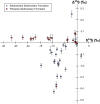The Great Oxidation Event preceded a Paleoproterozoic "snowball Earth"
- PMID: 32482849
- PMCID: PMC7306805
- DOI: 10.1073/pnas.2003090117
The Great Oxidation Event preceded a Paleoproterozoic "snowball Earth"
Abstract
The inability to resolve the exact temporal relationship between two pivotal events in Earth history, the Paleoproterozoic Great Oxidation Event (GOE) and the first "snowball Earth" global glaciation, has precluded assessing causality between changing atmospheric composition and ancient climate change. Here we present temporally resolved quadruple sulfur isotope measurements (δ34S, ∆33S, and ∆36S) from the Paleoproterozoic Seidorechka and Polisarka Sedimentary Formations on the Fennoscandian Shield, northwest Russia, that address this issue. Sulfides in the former preserve evidence of mass-independent fractionation of sulfur isotopes (S-MIF) falling within uncertainty of the Archean reference array with a ∆36S/∆33S slope of -1.8 and have small negative ∆33S values, whereas in the latter mass-dependent fractionation of sulfur isotopes (S-MDF) is evident, with a ∆36S/∆33S slope of -8.8. These trends, combined with geochronological constraints, place the S-MIF/S-MDF transition, the key indicator of the GOE, between 2,501.5 ± 1.7 Ma and 2,434 ± 6.6 Ma. These are the tightest temporal and stratigraphic constraints yet for the S-MIF/S-MDF transition and show that its timing in Fennoscandia is consistent with the S-MIF/S-MDF transition in North America and South Africa. Further, the glacigenic part of the Polisarka Formation occurs 60 m above the sedimentary succession containing S-MDF signals. Hence, our findings confirm unambiguously that the S-MIF/S-MDF transition preceded the Paleoproterozoic snowball Earth. Resolution of this temporal relationship constrains cause-and-effect drivers of Earth's oxygenation, specifically ruling out conceptual models in which global glaciation precedes or causes the evolution of oxygenic photosynthesis.
Keywords: Great Oxidation Event; mass independent fractionation; quadruple sulfur isotopes; snowball Earth.
Copyright © 2020 the Author(s). Published by PNAS.
Conflict of interest statement
The authors declare no competing interest.
Figures




References
-
- Farquhar J., Bao H., Thiemens M., Atmospheric influence of Earth’s earliest sulfur cycle. Science 289, 756–758 (2000). - PubMed
-
- Evans D. A., Beukes N. J., Kirschvink J. L., Low-latitude glaciation in the Palaeoproterozoic era. Nature 386, 262–266 (1997).
-
- Wang S. J., Rudnick R. L., Gaschnig R. M., Wang H., Wasylenki L. E., Methanogenesis sustained by sulfide weathering during the great oxidation event. Nat. Geosci. 12, 296–300 (2019).
Publication types
LinkOut - more resources
Full Text Sources
Miscellaneous

